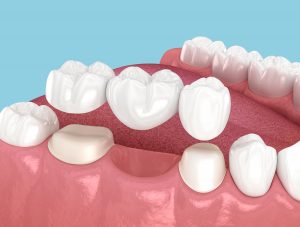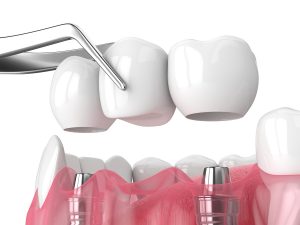Dental bridges are used to replace missing teeth and are often preferable to a denture. The replacement tooth, known as a pontic, is attached to the neighbouring “abutment” tooth/ teeth. A bridge can replace one or more teeth and is a permanent fixed solution.
When a tooth is lost or extracted, the surrounding teeth often move towards the now open space, sometimes within very short periods of time. The tooth in the jaw opposite the space can also erupt towards the space if it does not bite against anything else. These changes in tooth position can cause food to get stuck between the teeth that have moved, with subsequent soreness of the gums and an increased risk of decay, as well as problems with the bite. It is preferable to consider the replacement of a missing tooth before this occurs. Sometimes the bite may remain stable even after the loss of teeth, and in these situations your dentist may advise that you could leave the space, if it is not an aesthetic or functional problem for you.

One or more missing teeth may be replaced by the fabrication of a bridge. Teeth on one or both sides of the space can be used to anchor the bridge, either with some preparation of these teeth, or occasionally with no preparation at all. Abutment teeth must be healthy and relatively intact if they are to have enough strength to support a bridge.
Alternatives to bridgework include dentures, dental implants, or to leave the space as it is. Typically, an implant is the treatment of choice as it is very predictable, does not involve any damage to adjacent teeth, and will last many years if looked after. Dentures are removable, and are less ideal as they can promote collection of plaque and food debris around the adjacent teeth. Your dentist will always advise and discuss all these alternatives in order to help you select the most appropriate option.
There are two types of bridge that are available:
Conventional fixed bridgework involves preparing one or both teeth adjacent to the gap to receive a crown. The bridge consists of one or two abutment crowns and the replacement pontic tooth all in one metal/porcelain unit.
Conventional bridges provide an excellent aesthetic result and good long-term prognosis. However he preparation will involve removing some healthy tooth tissue that otherwise would not need to have anything done to it.
These consist of a metal wing glued onto the back of the abutment tooth adjacent to the gap, to which is connected the replacement pontic tooth; an assessment will need to be made to ensure a suitable aesthetic result can be achieved.
The advantage is that the preparation will involve very little (or sometimes no) reduction of the adjacent teeth. Because the bridge is bonded to an adjacent tooth, it can rarely come off, in which case it may require re-sticking periodically. A (most likely) metal wing will be attached to the tooth holding the bridge in place. All porcelain adhesive bridges are available for use in certain circumstances, and although they can be quite bulky, can offer an improved appearance over the metal wing.
On your first appointment the teeth are prepared to receive the bridge, and impressions are taken of the mouth. These are then sent to a laboratory, and it takes approximately two weeks for them to manufacture the bridge. Particularly if it is a front tooth, we might ask you to visit the technician at the laboratory to get a custom matched (colour) shade taken. On your second appointment, approximately 2 weeks later, the bridge is cemented permanently in place.

Your bridge can last many years if it is looked after properly. It needs to be cleaned everyday, as this prevents gum disease and bad breath. Special floss is available from us to allow you to clean under the bridge, as an ordinary toothbrush cannot reach there. Doing so daily prolongs the health of the the underlying gum and adjacent abutment, and thus the longevity of the bridge.
The procedure is minimally invasive and usually pain-free. We use local anaesthesia to ensure your comfort, and any mild discomfort after treatment can be managed with over-the-counter pain relief.
With good oral hygiene and regular dental visits, a bridge can last 10-15 years or more.
Yes! Other options include dental implants (a long-term, independent solution) and dentures (removable replacements). Our dentists will discuss the best option for your needs.

Fill in the form and our friendly team will be in touch with you momentarily
Heathwood Dental is a fantastic dental practice. Dr Vishal Kumar is very knowledgeable, highly skilled and always takes the time to talk through any proposed treatment and particular techniques/materi… Read More
I’m one step closer to my brand new tooth, despite being MANY years past the age of new teeth. Thanks to Neena and Mariska at Heathwood Dental I had a smooth, pain free, easy impant of the ‘socket’ in… Read More
I transferred to the Kings Road site when Vishal took over Heathwood Dental Practice from Dr Smith in 2005, it formerly being located in Ellis Road. Moving from a known dentist to someone new has alwa… Read More
Absolutely first rate service. Incredible expertise and use the latest techniques and materials. I travel nearly an hour to go here as it’s by far, the best practise I have ever been to by a considera… Read More
I cannot praise Heathwood Dental practice enough. All staff are extremely easy to deal with and pleasant. I have been treated for many years by Dr. Vishal Kumar and would recommend him to anyone. He i… Read More